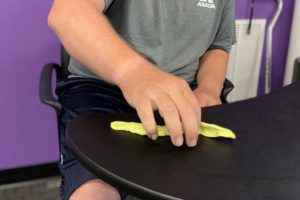Proper Sitting Posture
August 23, 2022
School is right around the corner, and you know what that means—It is time to swap the couch for the desk. With the plastic chairs and wooden desktops, it can sometimes seem hard to find a comfortable position to sit in. When on the couch, we have the luxury of leaning back, kicking our feet up, and resting our head on a pillow to help hold our necks in a good position. When at a desk, however, our options for comfort seem limited. We all have a tendency to rest our elbows on the desktop, place our head in our hands, and position our backs in a hunched-over position. What we don’t realize is how detrimental this position can actually be for our overall health.

Our bodies are made to rest in proper alignment-ears in line with the shoulders, shoulders back, equal weight bearing on both sides. Any time we leave this erect position, we add undue strain on all of our muscles and joints, which can cause pain. The number one complaint we get from those that sit at a desk most of the day is pain within the neck and back. Lucky for you, we have some key rules you can follow to avoid this unnecessary pain and discomfort.
- Keep your feet supported: It is suggested that you keep your feet firmly planted on either the floor or a step stool. Any time we sit without our feet supported, our pelvis has to shift, forcing our core to work extra hard to keep our spine in a neutral position. These small compensations at the core can create muscle imbalances overtime and begin to create pain at the low back.
- Keep your forearms rested on the desk: With your arms properly supported, you are able to prevent stress at the top end of the chain (the neck and shoulders). Typically, as our arms raise, our shoulders do as well, which could increase tension in the region between the neck and shoulders. With our arms rested on a solid surface near waist-height, we are able to keep our shoulders low and our muscles relaxed.
- Follow the 90-90-90 Rule: Your elbows, hips, and knees should all be bent at 90 degrees. If you look down and see your elbows are nearly straight, that may mean you need to bring your keyboard and/or mouse closer to you. If your hands are near your belly, you may need to slide the keyboard/mouse back or scoot your chair back just a little. In order to adjust the degree of flexion in your hips, simply adjust the height of your chair. Keep in mind, we need your feet supported and your knees to remain at 90 degrees of flexion as well. By adjusting the chair/seat height and height of your foot support, you’ll be able to maintain good posture for a longer period of time.
- Place the computer screen at or just below eye level: This is one of the harder adjustments to make when it comes to desk ergonomics. Many people will use a lift under their computer stand so they can easily adjust. Others will use a good old-fashioned phone book or catalog to get the proper height. You may have to get creative with your own desk in order to get the proper screen height. This is important to keep your neck in good alignment. If we are looking down for multiple hours throughout the day, we place extra stress on the vertebrae and muscles in our neck. After years in this position, we can actually develop what is called the Dowager’s Hump. Due to the weakness in our postural muscles along the backside of the neck and shoulders, our head starts to sit more forward and creates a more pronounced curvature within our vertebrae.
- Use a towel roll: As mentioned above, many of us prefer to lean forward onto our desktop and “lounge”. A simple towel roll can fix this habit and transform your sitting posture. All you need is a small hand towel from the kitchen or bathroom. Fold that hand towel in half and roll it up as tight as you can. You want to place it at the small of your back (belly button height). This little towel acts as a lever and automatically places your spine in a more erect position. It has the ability to take up to 400 pounds of pressure off your spine while sitting at your desk.

By keeping all of these rules in mind, you’ll be sure to find relief in your muscles and joints as you sit through your classes this upcoming school year. If you are already suffering from back pain or feel your posture is suffering due to your job or classes, give us, here at Witte Physical Therapy, a call so we can help get you straightened out!









